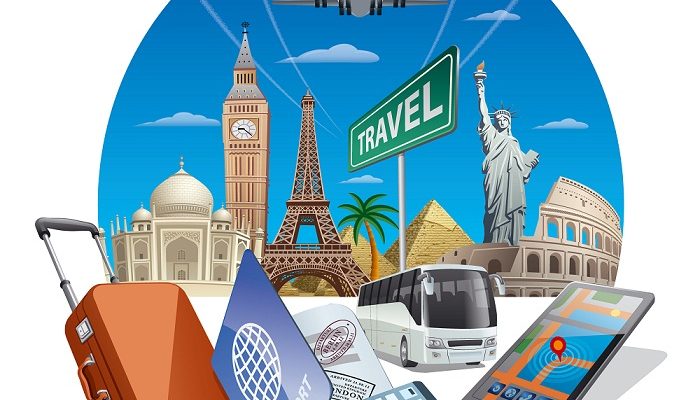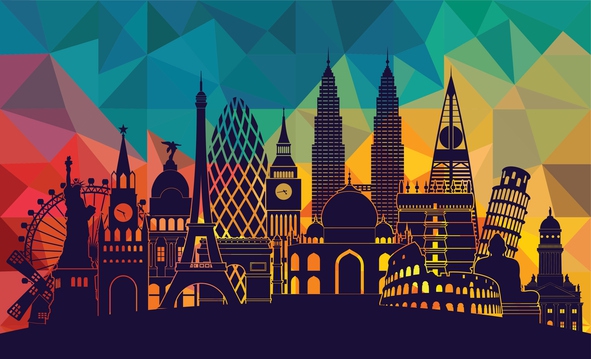Cambridge IGCSE Travel and Tourism
Cambridge IGCSE Travel and Tourism (0471) is designed to help meet the need for skilled and knowledgeable individuals in this rapidly diversifying industry. The syllabus develops practical skills across a range of working roles, as well as providing a global and local perspective on travel and tourism. Learners gain an overview of the industry, and learn about popular destinations, customer care, working procedures, travel and tourism products and services, and marketing and promotion. Through their studies, learners will gain an understanding of the concepts, models and theories used within the industry, and also enhance their skills of investigation, analysis, interpretation and evaluation.
Aims of the Syllabus
The aims of the Cambridge IGCSE Travel & Tourism syllabus are to provide candidates with-
• An understanding of the travel and tourism industry
• Theoretical knowledge of the industry and related sectors, including knowledge of travel and tourism products and services, the infrastructure on which they depend and the transport system needed to operate them
• Practical ability in a range of skills and procedures related to working in the travel and tourism industry, including knowledge of the essential personal and professional skills required by individuals working in the service sector
• Critical awareness of the physical, social and economic environments in which travel and tourism takes place, including understanding of the global, regional and local perspectives of travel and tourism.

Syllabus
Unit 1: The travel and tourism industry
1.1 Understand and explain the structure of the international travel and tourism industry
(a) Definitions of the industry:
• Travel (leisure, business, VFR – visiting friends and relatives)
• Travel services (retail and business travel agencies, tour operators, principals)
• Tourism services (national and regional tourist boards, tourist information centres)
• Tourist classifications (day tripper, length of stay, leisure or business and other purposes)
(b) Awareness of the roles of:
• Tourist boards
• Travel agents
• Tour operators
• Accommodation providers
• Transport providers
• Tourist attractions
• Catering outlets
• Entertainment venues
• Ancillary tourist services
1.2 Investigate the social, cultural, economic and environmental impact of travel and tourism
(a) Types of tourism impact (economic, environmental and social/cultural issues)
(b) Economic impacts-
• Tourism’s contribution to the balance of payments and employment
• Tourism multipliers, i.e. types, calculations, application to problems and links with economic development
• Impact on local economy
• Negative impacts of tourism (inflation, leakage, opportunity costs, over-dependence)
(c) Environmental impacts-
• Importance of the environment
• Positive effects – investment, conservation, regeneration, visitor management
• Negative effects – air, vegetation, wildlife, water quality, other pollution issues such as congestion
(d) Social and cultural impacts-
• The demonstration effect and nature of tourist/host encounter
• Positive and negative impacts – employment structures, morals, culture, health, traditions, loss of national identity
1.3 Identify the role of national governments in forming tourism policy and promotion
(a) The role of national and regional tourist boards
(b) Provision of travel and tourist information centres, in country and out of country
1.4 Investigate the patterns of demand for international travel and tourism
(a) Patterns of demand for international tourism; historic trends of international tourism, volume and value
(b) Major tourism generators and receiving countries in the world, including current trends
Unit 2: Features of worldwide destinations
2.1 Demonstrate knowledge of the main global features
(a) Location of major continental land masses, oceans and seas
(b) Location of the world’s major cities in relation to their importance as major transport hubs and destinations
2.2 Demonstrate awareness of different time zones and climates
(a) Relationship between global position (longitude) and time zones
(b) Relationship between global position (latitude) and physical environment (equatorial, tropical – including deserts, temperate, arctic)
(c) Influence of climate on tourism (relief, temperature, sunshine, precipitation, humidity, wind, hazards)
(d) Correct information on climatic areas identified, using reference sources
2.3 Investigate travel and tourism destinations
(a) Nature of destinations, e.g.:
• Perishable (they can be altered)
• Multiple use (people other than tourists use the destinations)
• Cultural appraisals (destinations are influenced by fashion)
Ingredients of a successful destination, e.g.: location, attractions, organisation, support facilities
(b) Tourist destinations as amalgams (combinations) of specific environmental factors such as attractions (natural and man-made), shopping centres, support facilities, hospitality and organisation
(c) Implications of viewing destinations as amalgams and the idea of sustainability
2.4 Identify and describe the features which attract tourists to a particular destination
(a) Features of location (climate, location, cultural, religious, etc.) identified and described, using reference sources
(b) Reasons why certain tourists (e.g. disabled, young people, families, business visitors) might be attracted to a location
(c) Influence of physical features on the opportunities and constraints for the development of tourism, e.g. mountains and hills, coasts and inland waterways
Unit 3: Customer care and working procedures
3.1 Deal with customers and colleagues – “the moment of truth”
(a) Importance of following customer care policies
(b) Necessity of good teamwork and training
(c) Importance of courtesy, tact and diplomacy recognised when dealing with customers and any specific needs
(d) Procedures for handling complaints
3.2 Identify the essential personal skills required when working in the travel and tourism industry
(a) Awareness of the need for essential personal and interpersonal skills in particular job roles
(b) Importance of personal presentation, clear speech, numeracy and literacy skills
(c) Awareness of applications of technology:
• computerised reservation systems
• other information technologies, such as: telephone, telex, video text, facsimile, Internet
3.3 Follow basic procedures when handling customer enquiries, making reservations and payments
(a) Customer’s requirements correctly interpreted upon receipt of an enquiry (in person, in writing, by telephone/fax/email)
(b) Simple reservation file prepared following set procedures, including use of diary for further action required
(c) Simple receipt issued and payments recorded
3.4 Use reference sources to obtain information
(a) Timetables, travel brochures and tariffs used to obtain accurate information
(b) Itinerary drawn up to meet customer’s requirements
(c) Use of computerised information systems and relevant technology to obtain information (Worldspan, Sabre, Galileo, World Wide Web)
(d) Exchange rate lists devised and used
3.5 Explore the presentation and promotion of tourist facilities
(a) Range of promotional methods and their use identified (e.g. visual displays for shop window, advertisements, leaflets, brochures, Internet)
Unit 4: Travel and tourism products and services
4.1 Identify and describe tourism products
(a) Inter-relationship between travel and transport, catering and accommodation, attractions, leisure and recreation and business facilities
(b) Components included in different tourism products (e.g. package, independent, all-inclusive holidays)
(c) Ancillary services – guiding, currency, marketing services
4.2 Explore the roles of tour operators and travel agents in the chain of distribution
(a) International tour operators (wholesalers):
• Tour operator’s product (transport plus accommodation)
• Types of tour operator (e.g. incoming tour operators)
• Nature of tour operations (how to put together a tour)
• Operating characteristics of tour operators (economics, scale of operations, seasonality, integration, importance of price, consumer protection)
(b) Retail travel agents:
• Role of travel agents
• Different services offered
• Understanding of travel agency appointments (e.g. ticket licensing) and conditions
• Operating characteristics
4.3 Describe support facilities for travel and tourism
(a) Concept of infrastructure – features of the built environment (utilities, roads, telecommunications, airports, ports), details of how they are funded, link with level of economic development
(b) Type and range of accommodation available (serviced/self-catering, hotels, guest houses, hostels, camping, luxury, budget, etc.):
• Economies of operation and scale of investment
• Measures of efficient operation, e.g. occupancy rates
• Classification and grading
• Facilities provided for business/leisure tourists
(c) Local public transport provision and relationship with improved accessibility – express links to airport (coach, rail, shuttle services), integrated rapid transit system or other forms of transportation
4.4 Explore the features of worldwide transport in relation to major international routes
(a) Air Transport:
• Main intercontinental routes and airports identified
• Types of air transport operation (charter and scheduled, domestic and international)
• Operating economics of air transport, full fare versus budget (‘no frills’)
• Government regulation/deregulation of air transport
• The advantages and disadvantages of regulation
• Air transport and tourism development – the role of governments and international bodies (e.g. IATA)
(b) Sea transport:
• Main ports and international passenger ferry routes identified
• Operating economies of sea transport
• Major types of sea transport for tourism – passenger ferries (and major crossing areas), cruise ships (and major cruise circuits)
(c) Rail and road transport:
• Major international tourist networks
• Nature and operating economies of rail and road transport
• Importance of motor transport in tourism

Objectrives of Assessment
1. Knowledge with understanding
Candidates should be able to-
A. Recall, select and present relevant factual information.
B. Demonstrate and apply knowledge with understanding of the correct use of the following in the travel and tourism industry:
(i) commonplace terms, definitions and facts
(ii) major concepts, models, patterns, principles and theories.
2. Investigation and analysis of evidence
Candidates should be able to-
A. Collect evidence from both primary and secondary sources, under guidance or independently, and be aware of the limitations of the various collection methods.
B. Record, classify and organise relevant evidence from an investigation in a clear and coherent form.
C. Present the evidence in an appropriate form and effective manner, using a wide range of appropriate skills and techniques, including verbal, numerical, diagrammatic, cartographic, pictorial and graphical methods.
D. Apply knowledge and understanding to select relevant data, recognise patterns and analyse evidence.
3. Interpretation and evaluation
Candidates should be able to-
A. Communicate their ideas and opinions in an accurate, concise and logical manner.
B. Present reasoned explanations for phenomena, patterns and relationships.
C. Understand the implications of, and draw inferences from, data and evidence.
D. Discuss and evaluate choices, and make reasoned decisions, recommendations and judgements.
E. Draw valid conclusions by a reasoned consideration of evidence.
Assessment
Paper 1
Core Paper
Short answer question paper
60% of total marks
100 marks
2 hours
Paper 2
Alternative to Coursework
Short answer question paper, based primarily on Unit 5 of the syllabus
40% of total marks
100 marks
2½ hours
Paper 3
Coursework Investigation (max 3000 words)
Centre-based assessment, directed towards Unit 6 of the syllabus
40% of total marks
60 marks
Want to improve your grades? Request for one to one online tutoring at Vidyalai.com with the best teachers. 100% money back guarantee. Signup now!